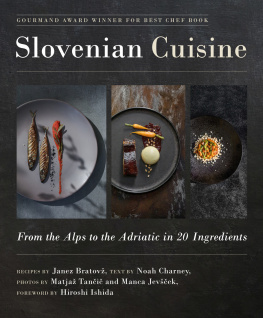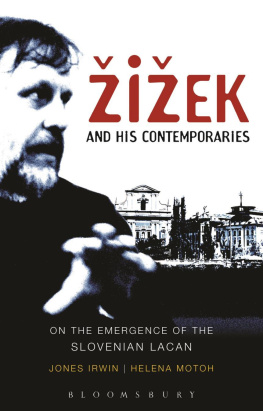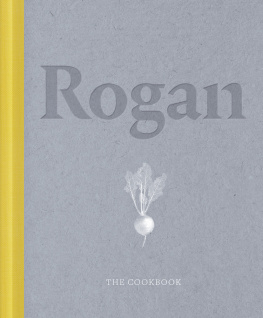



SLOVENIAN CUISINE
FROM THE ALPS TO THE ADRIATIC IN 20 INGREDIENTS
Recipes: JANEZ BRATOV
Text: NOAH CHARNEY
Portrait photos: MATJA TANI
Food photos: MANCA JEVEK
Design: ARE KERIN / FUTURA DDB
Typesetting: MARJAN BOI / FUTURA DDB
Translations: ALENKA BRATINA
Foreword: HIROSHI ISHIDA
DISHES FILLED WITH DREAMS AND KINDNESS
It is my great pleasure to write a foreword for Chef Janez Bratovs new cookbook.
Janez first came to our restaurant, Mibu, in the summer of 2008. It was a surprise to me when he singled out one dishblackened Kamo-nasu (eggplant). When he said that he was impressed with our dish, I immediately sensed that this chef must be on the same wavelength as I am. For this dish, the big and round Kamo-nasu eggplant, one of the traditional vegetables of Kyoto, was slowly roasted, without any spice, until its skin became blackened. By concentrating the eggplant juices and sweetness and adding a roasted aroma, umami develops and, at this tastiest moment, we serve the freshly-cooked hot eggplant to our guests. The eggplant, roasted without being cut, keeps its natural shape and looks so noble that it reminded me of the image of a meditating monk in a black gown that I venerated. Thus, the dish was named Zazen nasu, or meditation eggplant.
If we may describe Western cuisine as the art of flavoring, Japanese cuisine differs, and its essence is to appreciate the inherent characteristics of all sorts of food, such as vegetables and fish. Janez kindly expressed that he was impressed with the dishs sublime essence.
Soon after his visit, I had an opportunity to visit Slovenia. The dishes Janez created were filled with dreams and kindness, just as Janez is himself. The beauty of the food arranged on the plates in the dishes struck me. It felt like a prayer of his appreciation of the souls of each food and of modestly accepting them deep in his heart. I sympathized and, at the same time, I was attracted to his cuisine.
Both Slovenia and Japan have four seasons. The two countries enjoy wonderful products from the ocean, mountains, and fields, which have been appreciated and protected since long ago. Not only were we fortunate to have been born to these beautiful lands, with their abundant nature, but we have a fortunate destiny to deliver their blessing of food and harvest to others.
To a dear friend, congratulations, and I would like to share with you a teaching from a Zen nun whom I admire and always keep in mind while working: In the rain and the wind, take your umbrella, but only open it 70% of the way. Whatever you may do, be careful not to extend it fully.
Hiroyoshi ISHIDA
Chef of MIBU Restaurant


CONTENTS
JB
Little Janez lies in the high grasses beside a stream behind his grandmothers house in Trzin. His parents call to him. They are dressed in their finest clothes, just back from Germany where they have spent the last three years. Born in 1962, he has not seen them since they left in 1965, when he was three years old, and his brother was two. His father had found work abroad as a central heating engineer, and it paid so much more than what they could earn at home in Yugoslavia, that they determined it was worth whatever emotional loss might be suffered by their two sons to leave, returning once they'd earned enough to build a house and give their children a better life. It must have been an aching decision but, at the time, it was the sort of decision that many people in their situation would have made. But that did not make it any easier for little Janez and his brother, who spent these three formative years in the arms of their loving grandmother, Pavla.
When his parents finally did return and were calling out to Janez, the mixed emotions of his age and their absence led him to initially hide from them. When he didnt respond to their calls, his father was concerned that he had fallen into the stream and charged forward, in his Sunday best, ruining his clothes, expensively bought abroad, and plowed through the water in search of his son to save him.
This is JBs earliest memory, and it is a powerful one. His first memories related to food are at the home of his grandmother. Pavla was particularly poor and they lived in a modest house, poor enough that it was a treat to get a meal of meat or eggs. He fondly remembers her cooking eggs fried in pork cracklings. And it is fitting, then, that one of his most famous dishes at his eponymous restaurant, JB in Ljubljanaranked among the 100 best restaurants in the world in 2010 and in 2012 listed among the 10 best in Europeis a throwback, a Proustian sense memory experience recalling those fried eggs in cracklings, but refined to the level of a high-end restaurant of the sort he has run now for two decades. JB serves a fresh egg yolk onto which sparking-hot oil from cracklings is poured directly at the table. The heat of the oil ideally cooks the egg, and there is house-made bread for dipping. It couldnt be simpler. It is heavenly. It is heartfelt. It is integral to his story.
The JB restaurant is located on the ground floor of the Triglav Insurance Building, which was designed by modernist architect, Joe Plenik, the greatest ever Slovenian-born architect. Established in 1992, JB the restaurant was the first fine-dining establishment in newly-independent Slovenia. That made JB, the chef, the first to bring nouvelle cuisine to Yugoslavia, and of course to his homeland, the Republic of Slovenia, which declared independence in 1991. Prior to JBs return to Slovenia, after many years working at high-end restaurants in Austria, Slovenians had rarely heard of, and still less frequently encountered, things like carpaccio, ceviche, foams and gels, or even meat cooked rare, rather than well done. He was a revolutionary, and so remains.
JB was introduced to exotic foods early on. His father was a bon vivant and frequently returned to Germany for work, always bringing back something unusual to eat, at least by Yugoslav standards. White asparagus and blue cheese were all but unheard of. So, when his father brought these delicacies back from abroad, it was the talk of the town. During one of these parental sojourns abroad, when JB and his brother were with their grandmother, the area around which they lived was flooded, and they had to leave their home for a period of time. They were taken in by some neighbors who were a bit better off, occupying a two-story house and stocked with foods that were beyond the budget of JBs family. The one he remembers most fondly was oatmeal. He had never encountered oatmeal before, but ate it for breakfast while staying with this kind neighbor family. These sort of sense memories are among the most powerful: what a beloved family member cooked for us when we were little strikes a bell that may have receded in our minds, but which still resounds clearly when struck.
Next page













